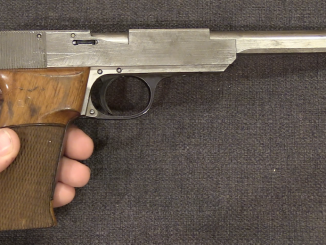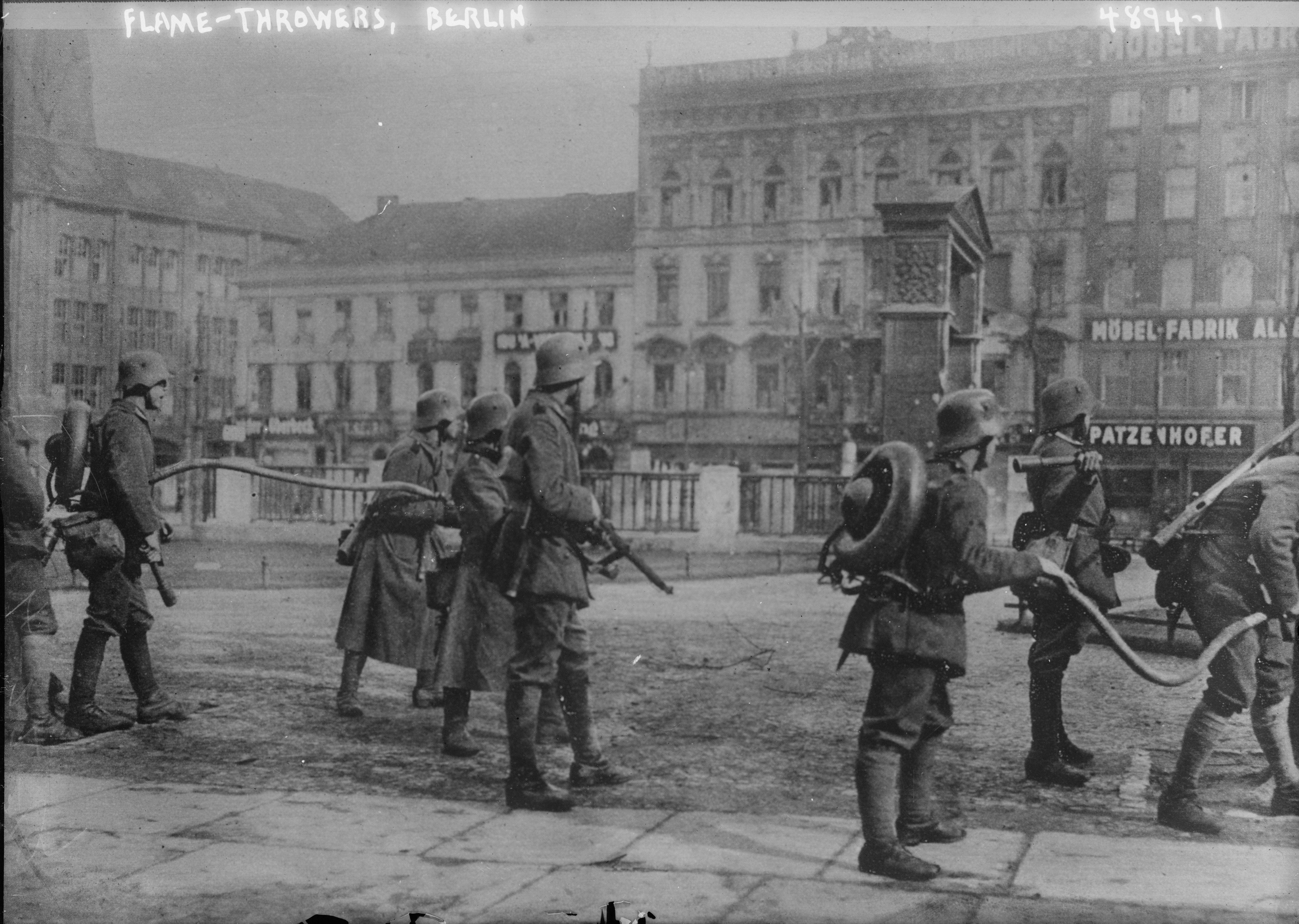Like most countries, Germany had a standard-issue antitank rifle when World War II began – the Panzerbuchse 39. It fired an 8x94mm cartridge with a small very high velocity armor-piercing bullet. And like the other AT rifles from the 1930s, the PzB-39 became obsolete quickly as tank armor improved during the war. However, while most countries simply scrapped their antitank rifles, the Germans opted instead to convert the guns into dedicated grenade launchers: the Granatbuchse 39.
Because the PzB-39 was already designed for a very high pressure cartridge, it was ideally suited to handle the stresses of firing large anti-tank grenades. Rather than relying on simple kinetic energy to penetrate, the grenades could use shaped charge technology to be vastly more effective than AP bullets.
In converting the PzB-39 into the GrB-39, the barrels were cut down, grenade launching cups attached to the muzzles, new sights designed for grenade use, bipods lengthened, and the folding stocks were fixed in place. Most of the PzB-39 rifles in service were subject to these modifications, and the resulting GrB-39 guns were able to be reasonably effective through the end of the war.




As these weapons fired standard rifle grenades what would be the advantage toward using a 98k with the Schiessbecher attached? Range seems to have been equally limited.
They didn’t use standard grenades; they used much heavier ones.
According to Ian Hogg’s book on Twentieth Century Artillery, the GrB-39 could also fire standard rifle grenades, sparing the squad’s Kar98’s from the wear and tear from having to grenade the enemy on their own. Treating the GrB-39 as the squad support weapon and anti-armor weapon seems to be a great idea, although I don’t know if the gunner could also just head-shoot some would-be hero with the wooden bullets should he not have time to fix the grenade to the cup…
Yes, but what about the weight penalty? The 98k could fire the same grenade, but would probably weigh only half of the Granatbuchse.
That weight would at least keep the grenade launcher from bucking around, otherwise that grenade sight would be worth absolutely nothing.
Also, firing any rifle grenade puts a tremendous load on the rifle, due to the grenade’s mass drastically increasing recoil force. Standard rifles tended to split their stocks with sustained grenade discharger use.
Even today you find SMLEs with brazed wire windings reinforcing the stock at forearm, in front of the action, and at the wrist. These were known as “EY” rifles, and were reserved for grenade discharger cup use. The wire not only kept the stock together, it was visual notification that it was only to be used as a “shooting” rifle in dire emergency.
The GrB 39 conversion was much heavier and more sturdily built. As such, it probably took less wear and tear from grenade launching duties.
cheers
eon
Ian, I am not sure it used different grenades.
The link mentioned above (http://www.rockislandauction.com/viewitem/aid/65/lid/1656) talks about the Gewehrgranate 46 and 61. These were standard grenades for the Schiessbecher, screwed on the Mauser 98k.
Also this original wartime intelligence report talks about the standard Schiessbecher (though there written as the Scheissbecher, no translation needed) http://www.lonesentry.com/ordnance/7-92-mm-granatbuchse-39-grenade-launching-rifle.html
This is clever solution given state of technology in early 40s. It would be interesting to see the grenade too to get full picture. The next step up I guess, would be to combine both, the propelling charge with payload into one single unit.
That may pose at risk to user if something goes wrong, though. Not that far fetched from XM-25….. without addition of electronics, of course.
Well said. Have you seen the Brixia Model 35 mortar? It was one of the most complicated but very effective and accurate light mortars of the war (the problem was the ammunition, not the mortar).
“It was one of the most complicated but very effective and accurate light mortars of the war (the problem was the ammunition, not the mortar).”
Why Brixia Modello 1935 were designed to use blank cartridge:
http://www.municion.org/65×52/8x42Brixia.htm
unlike other contemporary ~2inch (50mm) mortars (British 2-inch mortar, Polish Granatnik wz. 36, Soviet RM-38, Japanese Type 89, US M2 mortar)?
Actually, the next step up (in size but not concept) was the 3.7cm PaK 36 modified to fire an oversized, muzzle-loaded AT “bomb” with a blank round, very like an oversized rifle grenade;
https://en.wikipedia.org/wiki/Stielgranate_41
Lt. Col. Blacker may have been a bit piqued at the Germans more-or-less stealing one of his ideas.
cheers
eon
So: what is the hinged piece on top of the front sight for? It appears to rotate down in front of the front sight assembly. A close-range “battle sight”? (If they’re that close, you’re in deep kimchee…)
Based on the manual, it seems to be a protective coverplate for the front sight, to be folded down in front of it when the weapon is being carried, and the cutouts serve as an alternative front sight in case of darkness or damage making the crossed wires unusable.
“Rather than relying on simple kinetic energy to penetrate, the grenades could use shaped charge technology to be vastly more effective than AP bullets.”
Similarly when 3.7cm PaK become ineffective against tanks German developed Stielgranate 41 – over-caliber HEAT shell able to penetrate 180mm but at cost of lower muzzle velocity and therefore lower range/accuracy:
https://en.wikipedia.org/wiki/Stielgranate_41
Great video, Ian.
Question: Is that breech block fully in battery? When you were showing the rear sight, you could see a small part of the chamber still exposed…then again I didn’t catch if the cartridge is rimmed either, maybe that’s what’s going on….
When the top (square) edge of the breechblock is level with the top of its “slot”, the breech is fully closed, but the central “scallop” that allows passage of the casehead with the breech open still shows just a bit of the case rim at the top. I think this may have been intended as a visual check that there is still a round in the chamber.
A hinged, felt-lined dust cover of stamped steel swings over top of the block and latches to keep foreign material out. This light metal cover is often missing on surviving Grb39s.
cheers
eon
Weapon of choice scenario:
Given all the anti-armor weapons we discussed this week, which would you have if confronting a bunch of stolen armored cars (ranging from improvised armored trucks to the heavy Ba-10 with a 45mm tank gun) driven by slave-traders or ax-crazy militants?
1. Tank-Gewehr
2. Boys Rifle
3. PzB-39 or GrB-39
4. Type 97 or Type 98 AT cannon
5. Flamethrower Fougasse trap
6. MG 18 TuF
7. Panzerschreck (or Carl Gustav recoilless rifle)
8. 8.8 cm Pak 43/41
9. Semovente 90/53
10. VK 4501 (P) or VK 4502 (P) Hintern (both are Porsche prototype tanks…)
11. Death to all of those guys! Death–BY DRONE STRIKE!!!!
12. Or per the usual, screw the budget and add your favorite toys to this list.
I hope those bandits have car insurance. Why? Oh, no reason… (I’m going to percussively adjust their finances, it’s going to be so much fun…)
This activity is voluntary. You are not required to participate. Please keep any and all criticism of this post humane and free of foul language.
Thank you,
Cherndog
Ex-West German Bundesheer Gepard Flakpanzer. Twin 30mm guns, full-auto, can fire APHE rounds similar to those used by the GAU/8A Avenger cannon on the A-10. It still has the armor protection and mobility of the parent Leopard 1A3.
Give me a troop of them manned by crews who know what they’re about, and anything short of modern MBTs is likely to be in a world of hurt.
cheers
eon
Talk about literally chewing the scenery! I don’t anything bigger than a mouse could have survived all the flak!
This device has also been smoothbored to the groove diameter.
It could fire the standard rifle grenade over 400 metres, I have tried it with dummies.
Did the British ever contemplate doing this with their Boyes AT guns and how would it have compared with the PIAT?
There was only one(!!) type of grenade to be fired with the Granatbüchse 39: The “Große Gewehr-Panzergranate mit verbessertem Drallschaft” (large anti-tank rifle grenade with improved stem). This grenade was the only grenade that was allowed to be used because all others could be destroyed by the enormous pressure caused by the strong launching cartridge 318. Unfortunately the improved grenade looked similar to the standard grenade, only the colour of the stem was darker. So it was very important to look at the labels of the packaging.